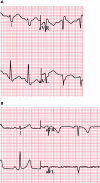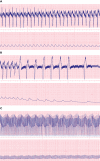Treatment of patients with cocaine-induced arrhythmias: bringing the bench to the bedside
- PMID: 20573080
- PMCID: PMC2856045
- DOI: 10.1111/j.1365-2125.2010.03632.x
Treatment of patients with cocaine-induced arrhythmias: bringing the bench to the bedside
Abstract
Widespread use of cocaine and its attendant toxicity has produced a wealth of benchwork studies and small animal investigations that evaluated the effects of cocaine on the cardiovascular system. Despite this wealth of knowledge, very little is known about the frequency or types of arrhythmias in patients with significant cocaine toxicity. The likely aetiologies; catecholamine excess, sodium channel blockade, potassium channel blockade, calcium channel effects, or ischaemia may act alone or in concert to produce a vast array of clinical findings that are modulated by hyperthermia, acidosis, hypoxia and electrolyte abnormalities. The initial paper in the series by Wood & Dargan providing the epidemiological framework of cocaine use and abuse is followed by a detailed review of the electrophysiological effects of cocaine by O'Leary & Hancox. This review is designed to complement the previous papers and focuses on the diagnosis and treatment of patients with cocaine-associated arrhythmias.
Figures



Similar articles
-
Role of voltage-gated sodium, potassium and calcium channels in the development of cocaine-associated cardiac arrhythmias.Br J Clin Pharmacol. 2010 May;69(5):427-42. doi: 10.1111/j.1365-2125.2010.03629.x. Br J Clin Pharmacol. 2010. PMID: 20573078 Free PMC article. Review.
-
Cocaine use and acute myocardial infarction.Emerg Med Clin North Am. 2001 May;19(2):493-510. doi: 10.1016/s0733-8627(05)70197-8. Emerg Med Clin North Am. 2001. PMID: 11373992 Review.
-
Putting cocaine use and cocaine-associated cardiac arrhythmias into epidemiological and clinical perspective.Br J Clin Pharmacol. 2010 May;69(5):443-7. doi: 10.1111/j.1365-2125.2010.03630.x. Br J Clin Pharmacol. 2010. PMID: 20573079 Free PMC article.
-
Management of cocaine-induced cardiac arrhythmias due to cardiac ion channel dysfunction.Clin Toxicol (Phila). 2009 Jan;47(1):14-23. doi: 10.1080/15563650802339373. Clin Toxicol (Phila). 2009. PMID: 18815938 Review.
-
[The heart and cocaine].Arch Mal Coeur Vaiss. 2001 Jun;94(6):600-4. Arch Mal Coeur Vaiss. 2001. PMID: 11480158 French.
Cited by
-
Nose-to-Heart Approach: Unveiling an Alternative Route of Acute Treatment.Biomedicines. 2024 Jan 16;12(1):198. doi: 10.3390/biomedicines12010198. Biomedicines. 2024. PMID: 38255302 Free PMC article. Review.
-
Acute and Chronic Effects of Cocaine on Cardiovascular Health.Int J Mol Sci. 2019 Jan 29;20(3):584. doi: 10.3390/ijms20030584. Int J Mol Sci. 2019. PMID: 30700023 Free PMC article. Review.
-
Dysrhythmias associated with cocaine overdose.Br J Clin Pharmacol. 2010 May;69(5):423-4. doi: 10.1111/j.1365-2125.2010.03675.x. Br J Clin Pharmacol. 2010. PMID: 20573076 Free PMC article. No abstract available.
-
Editors' pick 2010.Br J Clin Pharmacol. 2011 Jan;71(1):3-6. doi: 10.1111/j.1365-2125.2010.03862.x. Br J Clin Pharmacol. 2011. PMID: 21143495 Free PMC article. No abstract available.
-
The association between regular cocaine use, with and without tobacco co-use, and adverse cardiovascular and respiratory outcomes.Drug Alcohol Depend. 2020 Sep 1;214:108136. doi: 10.1016/j.drugalcdep.2020.108136. Epub 2020 Jun 27. Drug Alcohol Depend. 2020. PMID: 32623147 Free PMC article.
References
-
- Mittleman RE, Wetli CV. Cocaine and sudden ‘natural’ death. J Forensic Sci. 1987;32:11–9. - PubMed
-
- Mehta A, Jain AC, Mehta MC. Electrocardiographic effects of intravenous cocaine: an experimental study in a canine model. J Cardiovasc Pharmacol. 2003;41:25–30. - PubMed
-
- Macedo T, Ribeiro CA, Cotrim D, Tavares P, Morgadinho MT, Caramona M, Vicente MT, Rodrigues L, Cardoso MG, Keating ML. Catecholamine and MHPG plasma levels, platelet MAO activity, and 3H-imipramine binding in heroin and cocaine addicts. Mol Neurobiol. 1995;11:21–9. - PubMed
Publication types
MeSH terms
Substances
LinkOut - more resources
Full Text Sources
Medical

